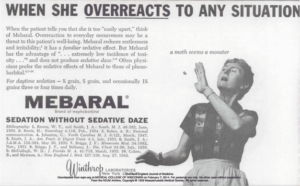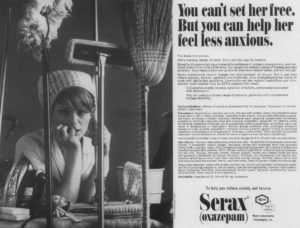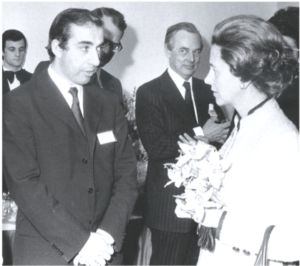
Benzodiazepines were discovered, serendipitously, by scientist Leo Sternbach when he was employed by Hoffman-La Roche in New Jersey. In 1955, Sternbach was working on a project with pharmacological compounds in an effort to replace the much stronger barbiturates, which are quite lethal in overdose, but the compounds initially prepared were disappointing so Sternbach abandoned the project.
In April 1957, Sternbach’s co-worker Earl Reeder was cleaning in the lab when he noticed a ‘nicely crystalline’ compound (which would be later named chlordiazepoxide, or Librium) left over from the deserted project. Because of Sternbach’s focus on other issues, this compound had not been tested two years prior. Without much expectation for pharmacology results to be positive, but with hope to publish the chemistry-related findings, this compound was submitted for a standard series of animal tests. To everyone’s surprise, the testing results indicated that the compound had very strong sedative, anticonvulsant and muscle relaxant effects. These impressive clinical findings led to the drug’s speedy introduction throughout the world in 1960 under the brand name Librium. Three years later, Diazepam (Valium) was launched. The two became the most commercially successful drugs for a time. By 1983 there were 17 benzodiazepines on the market worth nearly $3 billion worldwide. Currently, there are about 30 benzodiazepines available in Europe and the USA.

It did not take long for benzodiazepines to take off, become the most commonly prescribed of all drugs in the world in the 1970s. They were taken by an estimated one in five of all women and one in ten of all men in Europe at some time each year. The drugs were prescribed for complaints ranging from anxiety and depression to insomnia and ordinary life stress and were taken long-term, often for many years. Like many things, it was too good to be true.
Not long after, in the early 1980s, people taking prescribed benzodiazepines long-term in England realized themselves that the drugs tended to lose their efficacy over time and instead started to notice emerging adverse effects (tolerance withdrawal). Patients also found it difficult to stop taking benzodiazepines because of withdrawal effects, and many complained that they thought they had become “addicted”. (they were, in actuality, victims of iatrogenic dependence from as-prescribed long-term use). This led to a public outcry against benzodiazepines in the U.K. throughout the 1980s. There was widespread media coverage in the press, radio and television and a burgeoning of self-help groups and withdrawal clinics.
Due to this publicity, there was a reduction of benzodiazepine prescribing levels in the UK from its height of 32 million in 1976 (for a population of 50 million) down to about 18 million in 2000. And by 2000 the benzodiazepine problem was largely falsely assumed to have “gone away”. National Health withdrawal clinics shut down, the media no longer found benzodiazepines newsworthy and self-help groups closed down because of lack of public financial support.
Not long after came the introduction of the Z-drugs from 1998 through 2005: zopiclone/Imovane (introduced in 1998), zolpidem/Ambien and zaleplon/Sonata (in 2000) and eszopiclone/Lunesta (in 2005). Also in 2005, the FDA finalized approval for Ambien CR or extended-release zolpidem. Most recently, in 2012, the FDA approved Intermezzo, which still utilizes zolpidem as its active ingredient but is marketed for middle-of-the-night insomnia; it is available in doses only half of the strength of immediate-release Ambien (to supposedly avoid residual next-day sedation). The Z-drugs act very similarly benzodiazepines. Did anyone really think that they were going to be free of dependence potential and withdrawal?
The problem has not gone away. The scandal was merely concealed and swept under the rug. For example, there are still nearly one million long-term benzodiazepine users in the UK and four million or more in the US [as of 2005]. Benzodiazepines are still inappropriately prescribed at all stages of life — from the elderly who take them chronically as sleeping pills or are given them to keep them quiet in retirement homes and psychiatric units; to discharged psychiatric patients sent home from the hospital being told to continue taking benzodiazepines; to women still being prescribed them in pregnancy and, just generally, in greater percentages than men.
Why are benzodiazepines still so commonly prescribed inappropriately? One factor is that prescribers have failed to follow guidelines limiting them to short-term usage. They have dragged their feet, reluctant to abandon that the idea that benzodiazepines are so benign that they can be continued long-term or for life. Secondly, drug companies and prescribers have been slow to recognize the difference between different benzodiazepines, both in rates of elimination and in relative potency. Lastly, a failure on the part of prescribers to recognize individual differences amongst patients consuming benzodiazepines, which is when they are given in the wrong dose to the wrong people (e.g., elderly and other vulnerable patients).
There has been some organizing over the decades since the benzodiazepines were discovered to lose their efficacy, cause tolerance/interdose withdrawal, physical dependence and withdrawal symptoms on attempts at cessation. Unfortunately, these efforts have been largely fruitless as is detailed by this article
In 1979, Sen. Ted Kennedy led a senate subcommittee hearing into the drug’s’ dangers. The 1980’s and early 90’s saw the largest class action suit ever against British drug manufacturers which was unfortunately abandoned, largely due to legal costs. In 2002, the Maine Benzo Study Group comprised of physicians and other healthcare professionals concluded there was no evidence for long-term use. One recent positive development was that in 2016, the states of New York and Pennsylvania issued ‘prescribing guidelines’ recommending against use longer than several weeks [In 2004, the British government took a stand in limiting prolonged use, issuing advice to all doctors that the drugs should be prescribed only for short periods]. Nevertheless, benzos’s sordid history regarding long-term use is not translating to practice or common knowledge: they remain some of the most widely prescribed drugs in the world.
There is no question as to whether these drugs cause tolerance, physical dependence, adverse effects, and withdrawal syndromes—which are sometimes severe. The only questions that remain are: Will we learn from history, or allow it to continue to repeat itself? And for how much longer will this be allowed to persist—unchecked and unregulated, maiming, causing preventable suffering, and sometimes death—before governments and/or regulating bodies abandon their apathy and decide to act?
HISTORY OF DISCOVERING PROBLEMS WITH BENZODIAZEPINES: HOW DID THIS HAPPEN?

For the most part, it was a government-funded university professor and research scientist (Emeritus Professor Malcolm H. Lader, O.B.E., LL.B., D.Sc., Ph.D., M.D., F.R.C. Psych., F. Med. Sci.) and his colleagues in London, England, who were among the first scientists to pick up on the problems with benzodiazepines enough to want to look into it further. Unfortunately, when Lader requested funding from the Medical Research Council (MRC) for further research, he did not receive a response (on funding) and was given no explanation why.
In Professor Lader’s travels during his career, he often met with governments, ministries, and even royalty to discuss his findings. Pictured, left is discussions with Queen Fabiola of the Belgians on warnings of the impending benzodiazepine problem epidemic.
Lader details his experience and works with benzodiazepine research here.
Secret documents containing written proof of Lader’s requests for further research, and some of his research on benzodiazepine-related brain changes can be viewed here. These documents were sealed and labeled secret by the government, not to be opened until the year 2014, for reasons unbeknownst to the general public; the UK’s major news source The Independent blew the whistle after viewing these documents in November 2010; they had been opened in 2005 prior to this.
VINTAGE PHARMACEUTICAL ADS
Gallery of vintage ads for benzodiazepines and tranquilizers
ADDITIONAL READING ON BENZO HISTORY:
benzo.org.uk: History of Benzodiazepine Dependence
Psych Med Aware: What the textbooks may not tell you